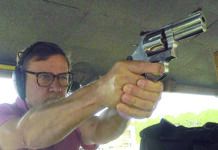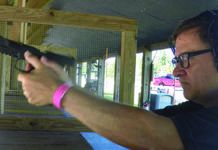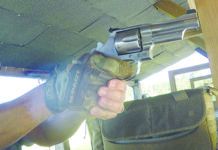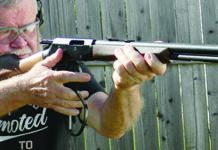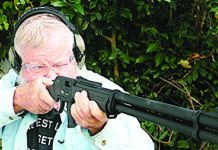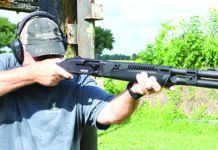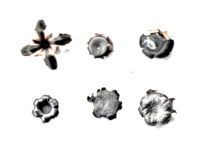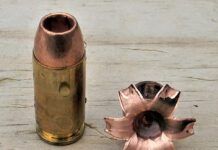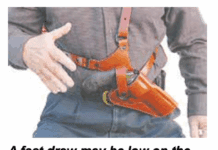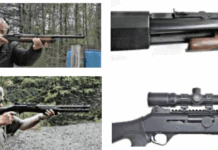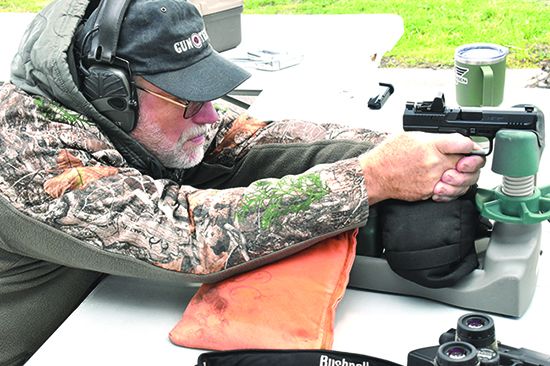Some members of the Houston test group are involved in teaching the Texas License To Carry class. The instruction includes a great deal of information about requirements for carry in Texas and the law regarding usage of those firearms. We also get asked about the best guns for carry. We tell them 1) the gun has to go bang, 2) it has to hit what they point it at, and 3) it needs to be sufficiently powerful. We normally recommend a minimum of 380 ACP. We also strongly suggest carrying a defensive firearm larger than a mouse gun, which tends to be easy to carry but is often difficult to shoot and has limited ammo capacity. Because we’ve never heard anyone who survived a gunfight say that they wish they had had a smaller gun or fewer cartridges, we normally suggest that they select the biggest gun they can, and will, carry.
Once properly enlightened, the LTC students most commonly choose a midsized pistol. The Glock Model 19 may well epitomize that group, but we think there are some other choices that are equally as good, or better. We collected three 9mm Luger samples that all sport less-than-full-length barrels and smaller frames but still maintain sufficient onboard ammo and good sights.
The first offering is one of the latest offerings from Canik. The Canik Mete SF HG5367, $455, ships ready for a red dot (as do the others) and comes compete with a real holster, tools, an extra backstrap, and even a magwell. It also sports one of the shortest, most usable triggers we’ve found on a polymer pistol.
The second is the Glock Model 48 MOS PA4850201FRMOS, $520. Roughly the same length and height as the famous G19, the G48 is slimmer, lighter, and easier to conceal while still allowing 10-round magazines. Of course, 15-round magazines are available aftermarket.
The third is Springfield Armory’s Ronin PX9117LAOS, $700. This is a Commander-length 1911-style pistol with a 4.25-inch barrel, blued slide, aluminum frame, and some very thin grips. Here’s what our shooters thought of these pistols when they fired the handguns side by side.
Canik Mete SF HG5367 9mm Luger
$455
Gun Tests grade: B+
Slightly larger than a Glock 19, this pistol shot well and had one of the best triggers we’ve found on a polymer pistol. There were some issues, however.
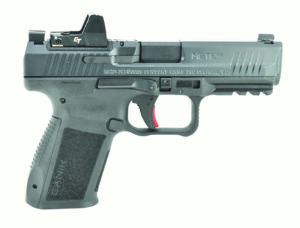
| Action Type | Semi-auto |
|---|---|
| Overall Length | 7.3 in. |
| Overall Height | 5.0 in. |
| Maximum Width | 1.39 in. |
| Weight Unloaded | 25.4 oz. |
| Weight Loaded | 34.2 oz. |
| Slide Material | Steel |
| Slide Retraction Effort | 18.7 lbs. |
| Receiver Material | Polymer |
| Receiver Finish | Matte-black polymer |
| Slide Finish | Tenifer |
| Front Strap Height | 2.25 in. |
| Back Strap Height | 3.25 in. |
| Barrel Length | 4.19 in. |
| Grip Thickness (Maximum) | 1.2 in. |
| Grip Circumference | 5.3 in. |
| Magazines | (2) 15 round |
| Rear Sight | Drift-adjustable white dots |
| Front Sight | Drift-adjustable white dot |
| Sight Radius | 6.5 in. |
| Trigger Pull Weight | 3.9 lbs. |
| Trigger Span | 3.1 in. |
| Safeties | Trigger blade, striker |
| Warranty | Limited lifetime |
| Telephone | (800) 527-1252 |
| Website | CanikUSA.com |
| Made In | Turkey |
With a firearms tradition that goes back centuries, the Turkish weapons industry has made significant strides in the 21st Century. Canik, one of the larger Turkish firms, started out about 20 years ago making products for the aerospace industry and can now boast of customers like Lockheed-Martin, Airbus, and Boeing. Using their production expertise to design pistols, the Canik TP Series semi-autos are the current choice of Turkish law enforcement.
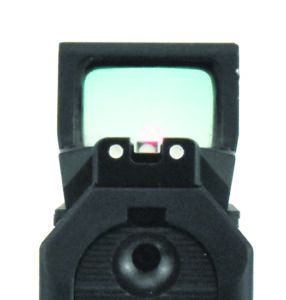
We selected the Mete SF model as a perfect fit for our “small enough to carry, big enough to shoot” requirement. Side by side with our Gen 3 Glock 19, the Canik is about a quarter-inch longer and a quarter-inch taller. Slide widths are also very similar, and the Canik’s grip is a bit thinner. Many of the Glock’s amenities are built into the Canik. The Mete SF sports grasping grooves fore and aft. The slide is beveled on the top to save some weight and to aid in reholstering. The Canik uses an exterior extractor and a striker that protrudes from the rear plate when fully cocked. The frame provides a three-slot Picatinny rail on the dust cover. Controls include a reversible magazine release and an ambidextrous slide release. The 4.19-inch fully-supported barrel uses conventional rifling. The barrel hood has a scallop cut in the rear that mates up with a hinged loaded-chamber indicator. It loads from 15-round metal magazines that inserted easily, fed reliably and dropped when told to.
Then we see where the Canik out Glocks the Glock. The drift-adjustable single-white-dot front sight is held in a dovetail as is the two-white-dot rear, both of which are made of metal. Disassembly is accomplished much the same as a Glock, but the Canik’s is easier in that the takedown tabs on the slide lock are large enough to easily engage. To remove the slide, first remove the mag and check the chamber several times. Point in a safe direction and press the trigger. While grasping the pistol with one hand, move the slide about 1⁄16-inch to the rear while pinching and pulling down on both tabs simultaneously. Instead of easing the slide forward and off the rails at this point, move the slide about a half-inch forward and lift off the rails. To reassemble, line the cutouts in the slide up with the tabs on the locking block. Set the slide down on the frame and slide to the rear. Easy peasy.
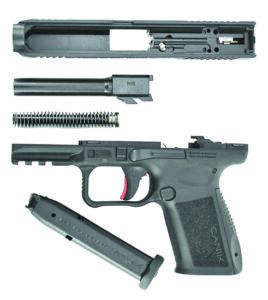
The slide on our sample is milled for a red-dot sight. Even when removed to mount the red-dot sight, there is still plenty of room to leave the tallish rear sight. We were able to direct-mount a Crimson Trace Rad Micro (CrimsonTrace.com, $185) to the slide. The Crimson Trace uses the same footprint as the Shield SMSc we mounted on the G48. Note that, once again, we had to find out which screws would fit. We found M4-.07 screws out of our stash of Swampfox (SwampFoxOptics.com) replacement screws did the trick. Canik provides two different mounting plates, along with a nice add-on magwell.
We also thought Canik did a good job on the grip frame. The front strap and the sides are stippled aggressively enough to maintain a grip without being overly aggressive. The backstrap is more rounded than flat. It is removable, providing two inserts to fit the hand. The trigger guard is relieved both in back and underneath to allow a little higher grip. The trigger was a very pleasant surprise. With about a half-inch of initial take up required, it hits the pressure wall when rotated to almost exactly 90 degrees. Required compression to complete the stroke averaged 3.9 pounds and was very crisp. This pistol has absolutely one of the best triggers we’ve found on a polymer pistol.
Our Team Said: The Canik came out in third place out of three. That said, it was still shooting consistent sub-2-inch groups at 15 yards. Function and feeding were perfect. The trigger was great for the speed drills — almost too good. We found that we could operate the trigger more quickly than we could bring the pistol back down out of recoil to set up the next shot. As a result, times were good, but accuracy suffered, throwing some of our follow-up shots out into the C, and even D, zones.
| 9MM LUGER RANGE DATA | |||
|---|---|---|---|
| Hornady Critical Defense 115-grain FTX 90260 | Springfield Ronin | Glock Model 48 | Canik Mete SF |
| Average Velocity | 1164 fps | 1126 fps | 1130 fps |
| Muzzle Energy | 346 ft.-lbs. | 324 ft.-lbs. | 326 ft.-lbs. |
| Best Group | 0.81 in. | 1.54 in. | 0.93 in. |
| Average Group | 1.28 in. | 1.72 in. | 1.25 in. |
| Aguila Ammunition 124-grain FMJ 1E092110 | Springfield Ronin | Glock Model 48 | Canik Mete SF |
| Average Velocity | 1121 fps | 1083 fps | 1109 fps |
| Muzzle Energy | 346 ft.-lbs. | 323 ft.-lbs. | 339 ft.-lbs. |
| Best Group | 1.00 in. | 1.43 in. | 1.42 in. |
| Average Group | 1.33 in. | 1.76 in. | 2.37 in. |
| Fiocchi Range Dynamics 147-grain FMJ 9APD | Springfield Ronin | Glock Model 48 | Canik Mete SF |
| Average Velocity | 977 fps | 939 fps | 943 fps |
| Muzzle Energy | 312 ft.-lbs. | 288 ft.-lbs. | 290 ft.-lbs. |
| Best Group | 1.23 in. | 1.47 in. | 1.13 in. |
| Average Group | 1.42 in. | 1.55 in. | 1.54 in. |
We compared our test guns at American Shooting Centers (AMShootCenters.com) in west Houston. We tested using three different types of ammunition. We started off with Hornady 115-grain Critical Defense loads, Aguila 124-grain full metal jackets, as well as Fiocchi 147-grain Range Dynamics FMJs. For accuracy, we fired five-shot groups at 15 yards from a well-sandbagged Caldwell Pistolero Shooting Rest (MidwayUSA.com 517357, $28) assisted by a Mini DRC Fortune Cookie from Wiebad.com (MINIFC, $75). We also wanted to test practical accuracy, so we did two additional tests. The first used 3-by-5 inch stickies attached to paper targets 5 yards downrange. We recorded first-shot times using 124-grain ammo. Then we shot three rounds, also at 5 yards, and using the same 3-by-5 inch label. The start position on all drills was from low ready. Velocities were obtained via the new Garmin Xero C1 Pro (Amazon, $600).
| DRILL NO. 1 DATA | |
|---|---|
| Pistol | Single Shot Average Time |
| Canik Mete SF | 0.78 |
| Glock Model 48 | 0.81 |
| Springfield Armory | 0.68 |
Process: Fire one shot from low ready at 3-by-5-inch label placed at 5 yards. Times in seconds are averages for eight repetitions.
| DRILL NO. 2 DATA | |||
|---|---|---|---|
| Pistol | 1st Shot | Split Average | Total Time |
| Canik Mete SF | 0.94 | 0.2 | 1.34 |
| Glock Model 48 | 0.99 | 0.26 | 1.51 |
| Springfield Armory | 0.72 | 0.2 | 1.12 |
Process: Fire three shots from low ready at 3-by-5-inch label placed at 5 yards. Times in seconds are averages for three repetitions.
Written and photographed by Joe Woolley, using evaluations from Gun Tests Team members. GT




